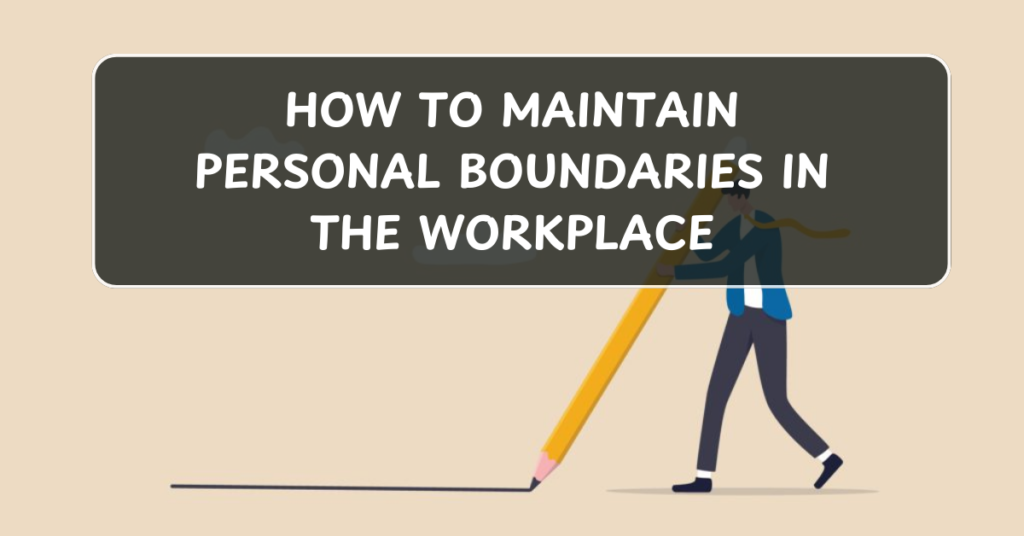
Maintaining personal boundaries in the workplace is essential for preserving your mental health, professional integrity, and overall well-being. Boundaries help you navigate the challenges of work relationships, prevent burnout, and create a healthy work-life balance. Establishing and respecting boundaries can be challenging in a professional environment, but with the right approach, you can protect your personal space while remaining professional. Here’s a guide on how to maintain personal boundaries at work.
1. Understand Your Boundaries
The first step in maintaining personal boundaries is to understand your own limits. Reflect on what you’re comfortable with and where you draw the line. Your boundaries can relate to your time, personal space, communication style, emotional energy, and privacy. By being clear on your boundaries, you’ll be better equipped to communicate them to others.
- Example: You may set a boundary around not answering work emails or messages outside of office hours to protect your personal time.
2. Set Clear Expectations from the Start
Establishing boundaries early on helps others understand your limits from the beginning. When you start a new job or begin a new project, take the time to communicate your boundaries to colleagues and supervisors. This sets a professional tone and helps avoid misunderstandings later.
- Example: If you prefer not to be interrupted during focused work hours, let your team know when you’ll be available for discussions and when you need uninterrupted time.
3. Learn to Say “No”
Saying “no” can be difficult, especially if you’re trying to be helpful or are worried about disappointing others. However, saying no is essential for maintaining boundaries. It’s important to recognize that you can’t take on every request or task without it negatively affecting your well-being. Saying no can be done respectfully and professionally, without guilt.
- Example: If a colleague asks you to take on additional work when you’re already overloaded, politely explain that your current workload prevents you from taking on more at this time.
4. Protect Your Time
Time management is a key component of maintaining boundaries. It’s easy to feel obligated to stay late, take on extra tasks, or always be available for colleagues, but this can lead to burnout. Be clear about your working hours and stick to them. Prioritize tasks that align with your goals and responsibilities, and delegate when possible.
- Example: Set a clear end time for your workday and avoid working past that time unless absolutely necessary. This helps preserve your personal time for relaxation and family.
5. Establish Physical Boundaries
Physical boundaries are equally important in the workplace. Maintaining your personal space, especially in open office environments, ensures that you can focus without distractions. You can also set boundaries when it comes to how you interact with others physically—whether it’s avoiding unwanted touches or maintaining personal distance.
- Example: If your workspace is shared, use personal items like headphones or a “do not disturb” sign to signal that you don’t wish to be interrupted.
6. Manage Emotional Boundaries
Emotional boundaries involve protecting your feelings from being manipulated, drained, or overwhelmed by others. Be mindful of how much emotional energy you’re investing in conversations or situations that may not be healthy. It’s important to recognize when others may be overstepping emotional boundaries, especially in difficult or toxic situations.
- Example: If a colleague constantly vents their personal issues to you, politely steer the conversation back to work topics or suggest they seek professional support.
7. Communicate Assertively
When it comes to setting boundaries, assertive communication is key. Be direct, calm, and respectful when explaining your limits to others. You don’t need to apologize or feel guilty for setting boundaries—it’s about being clear and protecting your well-being. Use “I” statements to express your feelings without sounding accusatory.
- Example: “I appreciate your input, but I need to focus on this task right now, and I can discuss this later.”
8. Respect Others’ Boundaries
Just as you need to protect your own boundaries, it’s equally important to respect the boundaries of your colleagues. Being aware of others’ needs and showing respect for their time and space helps build a more supportive and collaborative work environment. Practicing mutual respect fosters healthier relationships and prevents misunderstandings.
- Example: If a colleague prefers not to be interrupted during certain hours, respect that and wait for an appropriate time to approach them.
9. Set Boundaries Around Technology
In today’s digital age, work-life boundaries can easily blur due to constant connectivity. Setting boundaries around technology can help you maintain a healthy work-life balance. This can include limiting your use of work-related devices or emails outside of business hours or ensuring you take breaks from screens during the day.
- Example: Set an automatic email response after hours letting people know you’ll get back to them the next business day.
10. Know When to Seek Help
In some situations, your boundaries may be repeatedly tested or violated. If you find that your attempts to maintain boundaries aren’t being respected, it may be necessary to seek help from a supervisor, HR, or a trusted colleague. It’s important to address any boundary violations in a timely and professional manner to ensure that your well-being is prioritized.
- Example: If a coworker continually disrupts your work despite you expressing your need for focus time, consider discussing the issue with your manager or HR to find a solution.
11. Practice Self-Care
Maintaining boundaries in the workplace is an ongoing process that requires regular self-care. By taking care of your physical, emotional, and mental health, you’ll be better equipped to maintain healthy boundaries. Make time for activities that recharge you, such as exercise, hobbies, and spending time with loved ones.
- Example: Schedule regular breaks throughout the day to recharge, and take time off when needed to avoid burnout.
Conclusion
Maintaining personal boundaries in the workplace is a vital aspect of ensuring your well-being and maintaining a productive and respectful work environment. By being clear about your limits, practicing assertive communication, and respecting the boundaries of others, you can create a balanced and healthy professional life. Remember, boundaries are not about building walls—they’re about fostering mutual respect, reducing stress, and creating space for you to thrive both personally and professionally.


